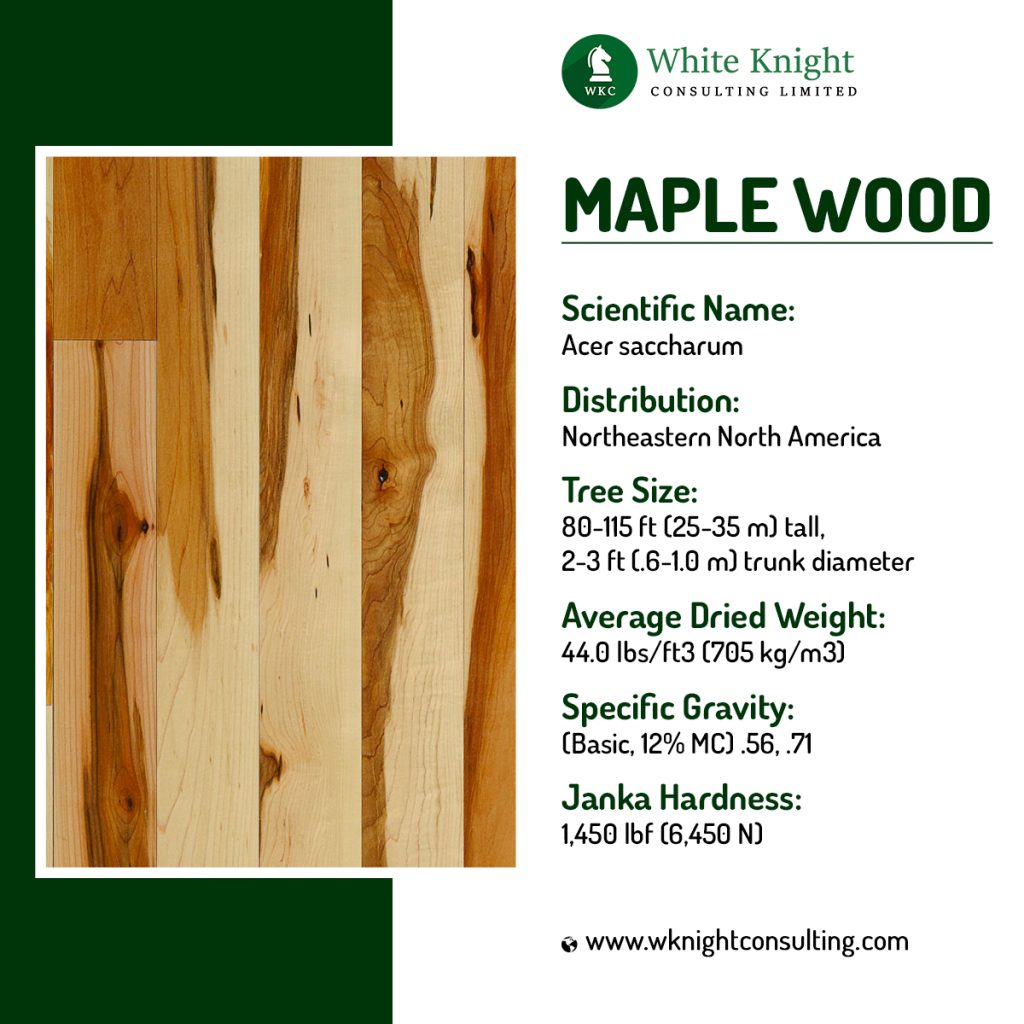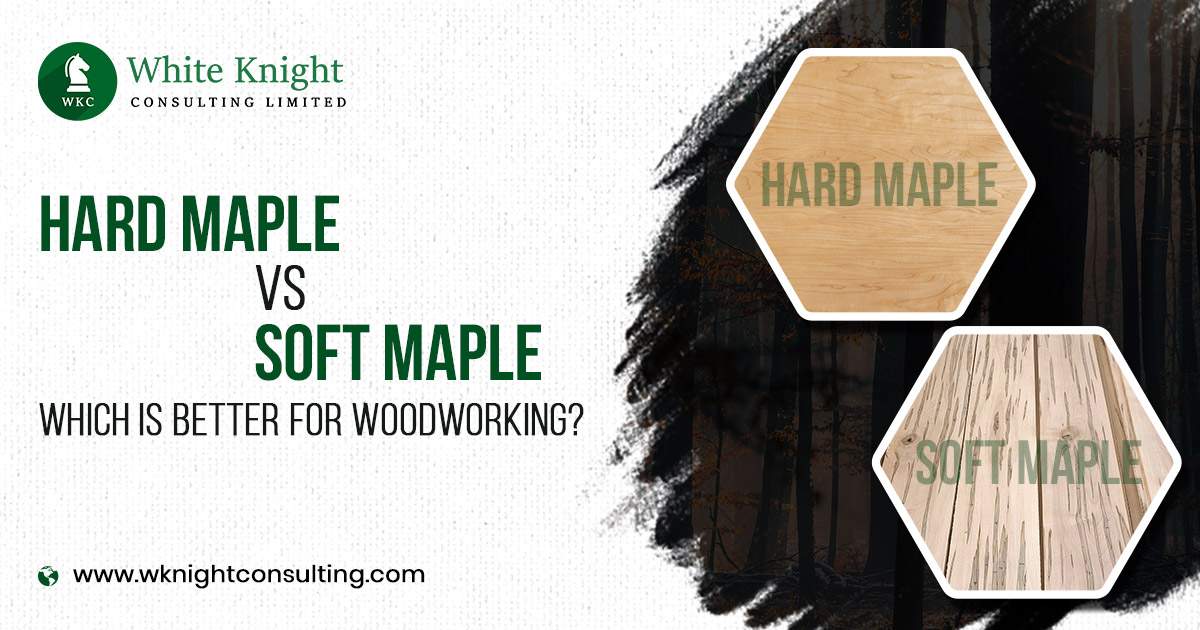Both hard maple and soft maple are hardwoods. Other than the obvious difference in hardness and density, there are various other differences between the two most common types of maple wood.
Hard maple is a term commonly used to refer to the two most popular species of maple wood – sugar maple and black maple. In fact, sugar maple is commonly called hard maple or rock maple due to its unparalleled hardness and density.
Soft maple is a term used to refer to multiple species of maple that are characterised by their lack of hardness. Soft maple species are not exactly soft, but they are slightly less hard than hard maple.
If you are looking to buy maple wood for your next project, make sure that you have a basic idea of the different types of maple along with an understanding of the differences between soft maple and hard maple.
What is Maple wood?
Maple is a popular hardwood used in a variety of woodworking projects, ranging from construction and furniture making to cabinetry, plywood, flooring and sports equipment.
Maple is one of the most popular hardwood timber found mainly in the regions of North America. It is prized for its durability, easy availability and affordability.
Maple wood, especially hard maple, is a naturally beautiful wood that looks nice both without and with staining. It is not just an incredibly strong timber but is also quite durable. The light, creamy colour of the maple sapwood makes it suitable for use in any domestic or commercial application.
One thing that might surprise you about maple is that the wood is mainly used for its sapwood and not its heartwood. Unlike other timbers, where heartwood is generally stronger and more durable than sapwood, maple sapwood is actually stronger with better properties than its heartwood, which makes it more useful in woodworking applications.
Note: Sapwood exists between heartwood and the bark in a tree. It is generally lighter in colour and has lower quality than heartwood. But, not in the case of maple, where sapwood is more useful than heartwood.
One of the reasons why maple is so popular among woodworkers is its remarkable versatility, as the wood can be easily stained in many hues for use in a variety of projects across furniture, cabinets, and musical instruments.
About Hard Maple

The term “hard maple” may refer to either the species hard maple commonly known as sugar maple or the category hard maple, which includes three maple species: sugar maple, black maple and Florida maple. The latter two species of hard maple are not nearly as popular or common as sugar maple for commercial use.
Hard maple or sugar maple is native to Northeastern North America. The trees are about 80-115 ft (25-35 m) tall with a 2-3 ft (.6-1.0 m) trunk diameter. The average dried weight of this wood is 705 kg/m3 and the Janka score is 1,450 lbf. It is a hard and moderately heavy wood.
The sapwood of hard maple is more useful than heartwood. It is a whitish or creamy colour, sometimes with a golden hue. The reddish-brown heartwood is perishable. The sapwood is strong and moderately durable. Hard maple is easy to work with and turns, glues, and finishes easily.
Hard maple is also famous for occasional figured grain patterns on its surface, which include birdseye, curly and quilted.
Hard maple is used for flooring, veneer, paper, cutting boards, furniture, sports equipment, and musical instruments. The tree is used for maple syrup.
About Soft Maple
Some of the major types of soft maple are bigleaf maple, red maple, silver maple, box elder, and striped maple.
Soft maple is a category of maple, which includes maple species that are comparatively less hard or strong than hard maple species. Different maple species have different characteristics in terms of appearance, strength, durability, workability, etc.
The Difference Between Hard Maple and Soft Maple
Do not let the word “soft” confuse you. Soft maples aren’t exactly very soft. In fact, they’re only about 25% softer than hard maple. This is the major difference between the two types.
Soft maples are not softwoods. Both soft maple and hard maple are hardwoods.
Hard Maple vs Soft Maple : Hardness
The major difference between hard maple and soft maple species is their hardness. Here’s a brief comparison of the hardness of different maple species.
The Janka hardness rating is a good way to determine the hardness of wood species. Here’s the Janka score of different maple species:
Hard Maple: ~1,450 lbf (pound-force)
Florida Maple: 1,240 lbf
Black Maple: 1,180 lbf
Red Maple: ~950 lbf
Bigleaf Maple: 850 lbf
Striped Maple: 770 lbf
Box Elder: 720 lbf
Silver Maple: 700 lbf
As you can see, there’s not a very big difference between the hardness of one maple species to another. In fact, black maple is only slightly harder than red maple (a type of soft maple). Silver Maple, the maple species with the lowest Janka rating is, in fact, quite hard in comparison to many other woods.
To sum up, hard maple (1,450 lbf) is about twice as hard as the least hard soft maple species (Silver Maple: 700 lbf)
Hard Maple vs Soft Maple : Weight
Because different maple species have different hardness ratings, the average dried weight of each maple is also unique, even if by a small margin. Weight is, therefore, a good way to identify maple species.
| MAPLE TYPE | AVERAGE DENSITY (in lbs/ft3) |
| Hard maple | 44 lbs/ft3 |
| Black maple | 40 lbs/ft3 |
| Bigleaf maple | 34 lbs/ft3 |
| Box elder | 32 lbs/ft3 |
| Red maple | 38 lbs/ft3 |
| Silver maple | 33 lbs/ft3 |
| Striped maple | 32 lbs/ft3 |
The higher the wood density, the higher the weight. Soft maple species clearly have lower density and less weight than hard maple species.
Hard Maple vs Soft Maple : Origin, trees (leaves) & Growth
One of the easiest ways to identify one maple type from another is to look at the tree, especially the leaves. The leaf of each maple is different. Hard maple, for instance, has leaves with either 5 or 7 loves, with colour ranging from yellow to orangish red. This is widely regarded as the standard maple leaf. Black maple leaves only have 3 lobes per leaf and are thicker. Bigleaf maple has the largest leaves of about 6 to 12 inches. Red maple has leaves similar to hard maple but they are red and the trees produce red flowers.
Hard maple is native to Northeastern North America and the trees are about 50 to 80 feet tall. Black maple is commonly found in the Northeastern United States with its trees about 80-115 feet tall. Florida Maple is common in the Southeastern U.S. Striped maple is mainly sourced from Eastern North America. Silver maple trees are around 50 ft to 100 ft tall and found in the Northeastern U.S. and Canada. Red maple is common in Eastern North America and its trees are about 30 to 100 feet tall. Box Elder is found in the central and eastern United States. Bigleaf production is limited to the coastal regions of Pacific North America.
Hard maple trees have a slow growth rate, about half of the growth speed of soft maple trees. This is why hard maple is so strong and dense. This also means that hard maple is less frequently harvested than soft maple, which is more easily and widely available.
Hard Maple vs Soft Maple : Appearance
In terms of appearance, most of the maple species look similar, which makes it difficult to tell them apart, especially in finished pieces.
There is a small difference in terms of appearance between hard maple and soft maple, which can be noticed when looked at closely. While the colour of hard maple is light and more uniform (consistent), soft maple is usually a bit darker and will generally have brown, grey, or red streaks.
If you look at the growth rings, you’ll notice that the growth rings in hard maple are closer together than in soft maple because of their high density.
Hard Maple vs Soft Maple : Ease of Work
All species of maple are generally easy to work with. The wood is known for being easy to glue and finish.
Being less dense, soft maple species are a little easier to work with than hard maple.
Also, hard maple’s high density can result in burn or dulling of cutting edges during shaping. This is not a problem with soft maple, which is easy and smooth to shape.
Hard Maple vs Soft Maple : Availability & Cost
As mentioned above, hard maple has a slower growth rate compared to soft maple, which grows about twice as fast. This is why soft maple is more easily and widely available than hard maple.
Hard maple is also slightly more expensive than soft maple species due to limited availability and high demand. Maple with figured patterns such as birdseye maple and quilted maple can be quite expensive.
Uses of Hard Maple and Soft Maple
Hard maple is mainly favoured for applications where the wood has to be hard and strong. For example flooring in heavy-traffic areas like offices can be made of hard maple. Other than that, it is commonly used for heavy furniture, workbenches, butcher blocks, cutting boards, flooring for basketball courts, musical instruments, sports equipment such as baseball bats, and turned objects.
Soft maple can be used as a substitute for hard maple in most applications, except for projects like flooring where extra hard and strong wood is needed. Other common uses of soft maple include paper, boxes, pallets, furniture, crates, railroad crossties, veneer, and wooden kitchenware.
Can Soft Maple Be Used as a Substitute for Hard Maple?
Yes. Some soft maple species are nearly as hard as black maple and other hard maple species. So, yes, soft maple can be used as a less expensive alternative to hard maple in projects where moderate hardness & density are required.
Where to Buy the Best Maple Wood in the World?
Due to the high demand for maple, there are now also fake products being sold as hard maple wood. Always buy your wood from a credible wood supplier online or in your local area.
If you’re looking to buy hard maple or soft maple wood that is sustainably produced and manufactured by skilled workers and is available at the best price with doorstep delivery in many countries including Canada, Malaysia, Australia, UAE, South Africa, Vietnam & more, you can contact White Knight Consulting Ltd to order maple wood in your preferred size and dimensions. If you need help selecting the right wood for your project, you can contact us to set up consulting with one of our experts.
